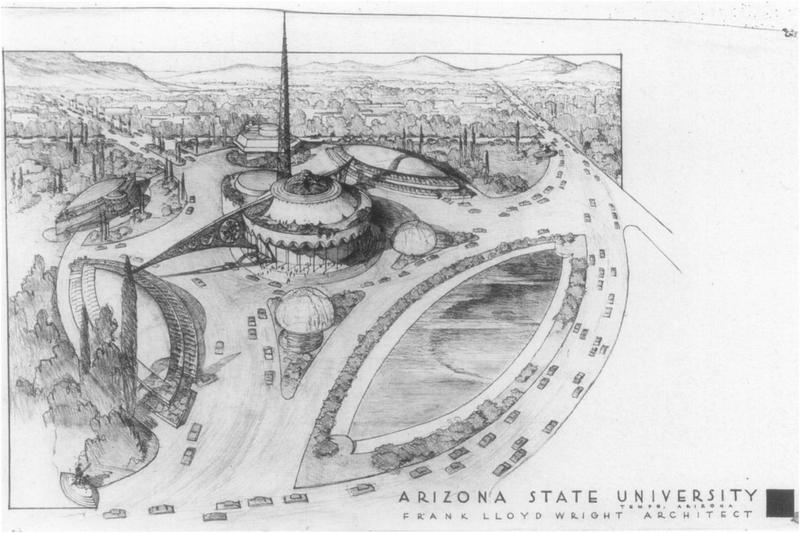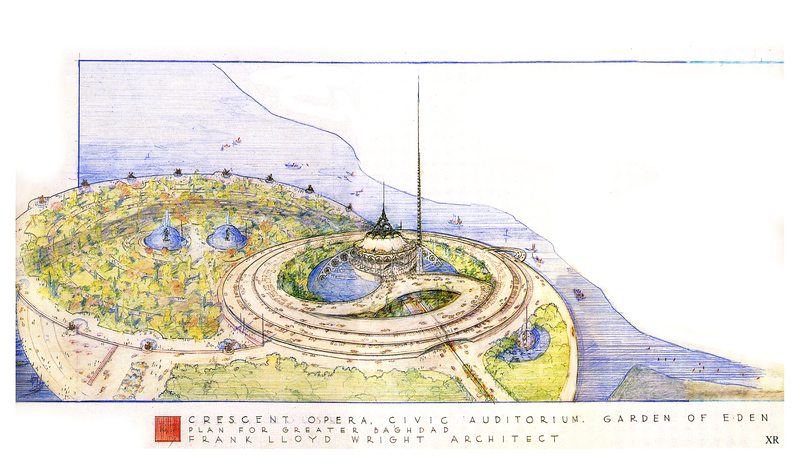
ASU's Gammage Auditorium has a surprising link to the proposed Baghdad Opera House.
It all began with two men. One, a master architect. The other, a university president leading a small school toward becoming a major university. Gammage Auditorium resulted from that collaboration--becoming a symbol for ASU and Tempe and emerging as a representation of Wright's enduring late-career ideas and influence. Frank Lloyd Wright is arguably the greatest (or at least most influential) American architect. His impact is visible everywhere in the United States. Not just evident in his artistic master creations such as Taliesin or Falling Water, Wright's influence extends to the ranch-style homes ubiquitous across American suburbs and the midwestern and western United States landscapes, especially in Phoenix and the southwest.
Wright's work was endlessly inventive, including the plan he developed for the Arizona State Capitol--the Oasis--in the 1950s, which influenced the development of Gammage Auditorium. As Arizona considered what to do with its state capitol building, it commissioned a number of designs, including several notable modernist designs that would have resulted in a high-rise office tower at the heart of the capitol grounds. Asked what he thought about the proposals in 1957, Wright reportedly stated, "Why comment? (The building proposal) is its own comment on Arizona." As he drew his response in a plan, he reportedly said, "To build an already dated New York monstrosity to stand up to present Arizona to posterity seems to me a crime." The debate and Wright's proposed capitol complex for Papago Park--which was sent to local newspapers--caught the eye of Grady Gammage. He approached him with the idea of designing a signature auditorium space.
Grady Gammage, President at ASU since 1933, had been shepherding the University from a small teacher's college into a major university. Joseph Siry, in his article, writes that Gammage's work had occurred methodically over two decades, with a singular goal of building a school that was:
"...worthy counterpart to his own alma mater, the older University of Arizona in Tuscon. Underlying his effort was a local consensus that Phoenix had to develop an institution that provided engineering and other graduate education in order to encourage major manufacturers to relocate in what then became promoted as the Valley of the Sun".
When his term started, ASU was still called The Arizona State Teachers College at Tempe. As he expanded the University's curriculum, he also grew its profile and identity. In 1958, after a hotly contested state-wide election, for example, voters approved Gammage's proposal to change the name to Arizona State University. As part of his broader plan for the University's physical plant, Gammage embarked on a post-war building campaign that drew assistance from state and federal sources and contributed to reshaping not just the campus, but Tempe itself. His plan included an auditorium to attract people from all over the central Arizona region. It would be located along Apache Boulevard, the major route into and out of the Phoenix area. It was where the federal highway system converged and brought traffic to and from the East through Mesa and into Tempe before curving and crossing the Salt River at the Mill Avenue Bridge. For Gammage, a signature building so prominently sited would serve as a capstone on decades of expansion. In the spring of 1957, after Gammage had read an article about Wright's Arizona Capitol building in the Phoenix Gazette, Grady reached out to Wright to ask about designing the Auditorium.
Wright seized the opportunity to bring his failed plan for a revolutionary Baghdad Opera House to fruition--from Baghdad and the Arabian Desert to Arizona's Sonora Desert. Part of a broader effort by mid-century architects to reimagine the post-war national capitols, the Baghdad Project also reflected Wright's interest in the geometric form of circle and arc, as well as an intense desire to build projects that reflect their local environments. The original drawings for the Baghdad Opera House did just that, reflecting its proposed location on an island in the Tigris River that bisected the city. Wright's proposals had been rejected, but he returned to those plans as he thought about an auditorium for another desert capital. Wright used a significant portion of the designs for the Opera house on the Auditorium. Even the most cursory examination of the planned facade of the Opera house, with its sweeping arches and upper-level balcony, compared to the Gammage Auditorium, shows substantial similarities. Further evidence of the connection between the Baghdad Opera House and Gammage Memorial Auditorium comes from Kay Gammage, who "remembered that when her husband drove out to Taliesin West to see Wright about building an auditorium at ASU, Wright shuffled around and got out some things he had for other place and [the Baghdad Opera House] was one of them." Gradually, the Baghdad Opera House would evolve into the plans for Gammage Auditorium.
After the Auditorium was built it would become a defining symbol for the University. The building is one of the most iconic on campus and is instantly recognizable. It marked the point when a relatively small teachers' college became a fully-fledged university. Most promotional brochures given or sent to prospective students for decades included some image of the Auditorium. Gammage also became a central figure in campus life. Wright once said to Gammage, "I'll build you a building that will be a gateway to your University. It will be a gateway to your intellectual level. It will introduce what you stand for...It will make your University." During a tour of the prospective spot for the Auditorium, Wright said, "...I believe this is the site. The structure should be circular in design-yes and with outstretched arms, saying 'Welcome to Arizona.' Wright imagined the Auditorium as a gateway to Arizona State's campus, as he had planned the Baghdad Opera House as a stately preface to the new Baghdad University." At a dinner party that took place during Wright's visit to the prospective location of the Auditorium, it is accounted that:
"After dinner, Mr. Wright banged on the table and said: "I feel the need to say something. I believe it's time that ASU grows up and be like a university. You are missing the one thing that would tie a university together. That is an auditorium or concert hall...I will build the building for you. I already have the plans drawn and they won't cost you a cent."
The Auditorium would also become a symbol of Tempe's community and Arizona's central region. Eventually, the City of Tempe would include an image of the Auditorium on its seal. The Auditorium also became "the main facility for the performing arts in the Phoenix area, which then held half the state's population and three-fourths of its building as the cultural center for the entire Southwest." Slowly but surely, the building became a regional symbol. It became everything that Frank Lloyd Wright hoped the rejected Arizona State Capitol building never was. Even today, it remains an important symbol of the University.
edited 10/13/2022: jlsImages




20 Wright, bird's-eye view of the auditorium and fine arts center Source: Siry Article, p. 283, figure 20.
Arizona State University, drawing no. 5911.005, FLWA, copyright © The Frank Lloyd Wri Foundation, Scottsdale, Arizona Creator: Frank Lloyd Wright Date: 1959?

A sketch by Frank Lloyd Wright, master architect, of the plan for the Baghdad Opera House. The plan greatly resembles that of Gammage Memorial Auditorium. Source: Flickr The Frank Lloyd Wright Foundation, Scottsdale, Arizona, drawing no. 5732.001 Creator: Frank Lloyd Wright Date: 1957
